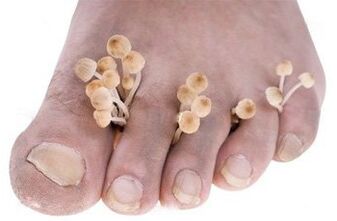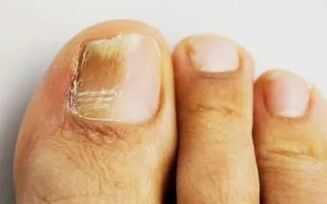
There are many types of fungi in the world, but only a few of them can infect the human body. Diseases caused by these microorganisms are called mycoses. People call these diseases fungi. The skin of the feet is most commonly affected. According to medical research, mycoses are the second most common skin disease. You need to start fighting foot fungus as soon as possible. By seeking timely medical help, a person not only quickly gets rid of the problem, but also protects loved ones from infection.
Signs of foot fungus (symptoms)
At the early stages of the development of the disease, the patient may not be bothered by anything. People assume that the skin on their feet is a bit uncomfortable for many other reasons and are not in a hurry to seek medical help. The first obvious symptoms appear when the fungus has spread significantly. Patients experience:
- redness of the skin of the feet;
- unpleasant odor from the feet;
- itching and burning;
- peeling skin.
Signs of the disease can vary greatly depending on its form. The most common is the alternating type. It causes the following symptoms of foot fungus:
- burning sensation in the feet;
- the appearance of cracks in the skin;
- peeling of the epidermis.
Corrosion areas may appear at the location of deep cracks. They bring severe discomfort to the patient, because when walking they cause pronounced pain. After that, the skin of the legs becomes very loose, which leads to a significant decrease in local immunity. As a result, a secondary infection joins the fungal infection, causing:
- Extensive plantar dermatitis;
- festering of affected areas;
- swelling and pain in the legs.
Fungi can also affect the nails. This type of disease is called onychomycosis. Its appearance will be indicated by a change in the color of the plate, thickening or thinning. If left untreated, the fungus will lead to damage to all nails or complete loss.
Cause of the disease
This disease is caused by some parasitic fungi. Most often, the disease occurs when affected by dermatophytes or red trichophyton. How to treat foot fungus can only be determined after the causative agent is identified. They all grow very well and reproduce quickly in warm, humid environments. In this regard, you can get infected by going to the following public places:

- sauna;
- Pool;
- soul;
- bathtub
Infection can also occur through contact with a sick person or that person's personal belongings. For example, people who use strangers are at risk of developing foot fungus:
- towel;
- pumice;
- washcloth;
- socks;
- Nail scissors.
Another factor influencing the rapid spread of the disease is the lack of proper foot hygiene. People who wear wet shoes or socks often get fungus. High sensitivity to mycoses is observed in people suffering from:
- increased foot sweating;
- endocrine disease;
- reduced immunity;
- diabetes;
- varicose veins.
Which doctor should I contact?
It is very difficult to cope with this disease on your own. A patient with such a problem needs the help of a qualified specialist. Your dermatologist will tell you how to treat athlete's foot.
At the first appointment, specialists will thoroughly examine the affected area of the foot. An experienced doctor will only need to visually evaluate the skin to make a diagnosis. But doctors also need to know how the disease appears. To do this, he will conduct a conversation with the patient. Patients will need to answer the following questions:

- How long ago did the first signs of athlete's foot appear?
- Has this problem bothered you before?
- Are there any chronic diseases?
- Has that person been in contact with sick people?
- Have you visited a sauna, steam room or swimming pool?
- Does your loved one have athlete's foot?
Based on the information received from the patient, the doctor can determine the true cause of the disease. To understand how to deal with a disease, you need to know exactly what the causative agent is. An inspection will help with this. Patients are prescribed skin shaving on the affected foot area. After laboratory testing, experts accurately identified the causative agent.
How to treat the disease?
The sooner a person seeks help, the faster treatment will be for him. Your doctor determines how to treat foot fungus after receiving the results of a diagnostic examination. Experts suggest fighting this disease with medication. Patients prescribed antifungal medications:
- prevent the growth of pathogens;
- destroy fungi;
- has anti-inflammatory effect;
- Reduce unpleasant symptoms.
These products are supplied as ointments, gels, sprays, tablets or oral suspensions. For fungus on toenails, special varnishes or plasters can be used, which also have an antifungal effect. The specialist chooses drugs for the patient on a strictly individual basis, since many of them have a number of contraindications. It is forbidden to use certain drugs for:
- pregnant women;
- mothers who are breastfeeding;
- children.
To achieve a quick recovery, it is very important to strengthen the immune system. To do this, the patient is prescribed vitamin-mineral complexes and immunostimulants. In severe cases, when the secondary infection is related to a fungal infection, the patient is prescribed antibiotics.
How to cure foot fungus permanently?
Many patients complain that the disease returns some time after completing treatment. The reason for this is that the primary infection is not completely cured. A common mistake many people make is to stop treatment when they see improvement. It is very important to continue using the medication for the entire time prescribed by your doctor. Even if the disease does not appear outwardly, it is not true that the entire infection has been defeated. To prevent recurring damage to your legs, you need to:
- Strictly follow expert recommendations.
- Do not replace the medicine with analogues on your own.
- Apply the product regularly, without breaks.
During treatment, patients must wear closed slippers at home. You should not let other family members wear it because it can spread infection through it. When treating foot fungus, it is also forbidden to walk barefoot on the floor or share towels, pumice stones or other bathing accessories with others. It is very important during therapy:
- Wash the patient's clothes separately from others.
- Perform daily wet cleaning of the house.
- Treat the patient's shoes with antifungal medication.
You also need to take foot hygiene seriously. They must be washed at least 2 times a day. At the same time, they should be treated with hot water. It is important to change socks regularly and wear comfortable, not tight shoes. After recovery, you must definitely throw away slippers, towels, washcloths, socks that the person used during the illness.
Prevent
Knowing the causes of foot fungus, you can easily prevent it. To avoid this disease, you just need to adhere to the following prevention rules:
- When going to the bathhouse, sauna or swimming pool, use only disposable or personal slippers.
- Do not wear wet or damp shoes.
- If there is a sick person in the house, only use personal bathing accessories.
Some diseases also increase the risk of fungal diseases. Therefore, by removing them in time, the occurrence of the disease can be avoided. People who are suffering from:
- flat feet;
- corn;
- foot hyperhidrosis.
It is important for everyone to know that at low temperatures, mushrooms survive for a long time. So freezing is not scary for him. However, pathogens will die when exposed to high temperatures. So boiling can be used for preventive purposes. If you treat the patient's clothes and shoes in this way, the fungus on them will die.


























